Posted by Anita on 12.23.08 3:27 AM
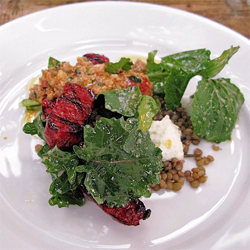 Here’s a recipe for a magical midwinter’s afternoon: Take the Tube to Richmond, a village on the fringes of London, then hop a red double-decker bus for a ride along the Thames. Alight in front of the cheery half-timbered pub, walk down the church lane past the Celtic stone crosses, left at the split-rail fence, and bob’s your uncle: You’ve arrived at Petersham Nurseries.
Here’s a recipe for a magical midwinter’s afternoon: Take the Tube to Richmond, a village on the fringes of London, then hop a red double-decker bus for a ride along the Thames. Alight in front of the cheery half-timbered pub, walk down the church lane past the Celtic stone crosses, left at the split-rail fence, and bob’s your uncle: You’ve arrived at Petersham Nurseries.
Now, even if an afternoon at a garden centre is not your idea of holiday time well spent, bear with me. Remember that the English excel at creating magical places, at planting beautiful gardens, at the eternal joy that is lunchtime. So it should come as no surprise that a mid-day repast inside a converted greenhouse — complete with dirt floors, mismatched chairs, and waitresses wearing muckboots with skirts — would be just the sort of adventure that would pay off very handsomely indeed.
Take your seat under the heater, and start with the seasonal sparkler — say, vanilla-rhubarb prosecco — then pick an appetizer to share. (If the chorizo starter with with lentils, caprini fresca, and agresto is on the menu, please order it; you won’t be sorry.) Pick your mains from a short list, one of which always seems to be vegetarian and another fish. Chef Skye Gyngell’s team “sources the best-quality seasonal ingredients that we can lay our hands on”, so you might opt for a whole roasted partridge with farro, chard, and salsa verde, or perhaps a fillet of sea bass served with clams, fino, arrocina beans, and aioli. Make sure to save room for dessert: The hazlenut tart comes with a generous drizzle of chocolate sauce and a dollop of airy crême fraiche.
Should you need to freshen up, you’ll find the loos in the hobbit-like wooden structure that houses the cafe kitchen and the teahouse. The latter — if you’ve neglected to book ahead, or just fancy a lighter nosh — offers a daily soup served with good bread and a hodgepodge of sweet cakes. And tea, of course. Always tea.
The nursery yard itself is full of all sorts of treasures, so if you’re a gardening buff — or, really, even if you aren’t — be sure to budget enough time to stroll and browse. The last lunch reservation is taken at 2:45, but the retail side remains open until 5pm, although in the dwindling light of wintertime you might plan to come early rather than stay late.
Bundle up and stroll back down the lane to the bus stop, where the diamond-paned windows of the pub now glow with holiday cheer. Your bus will be along promptly — this is England, after all — ready to whisk you back up the hill to Richmond and the real world… full, happy, and content.

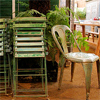



Petersham Nurseries & Cafe
Church Lane, off Petersham Road
Richmond
Surrey TW10 7AG
020 8940 5230
garden, locavore, London, lunch, restaurants, travel
3 Comments »




Posted by Anita on 11.21.08 11:14 PM
 I feel downright terrible that it’s taken me this long to tell you about the fabulous time we had last month in Seattle at Le Mixeur, the exclusive soirée organized by the Munat Bros, Ted & Charles. But in my defense, it’s taken me this long to figure out how to explain it without sounding like I’m bragging. Because, dear reader, saying Le Mixeur is a cocktail party is like calling the Titanic a boat: Technically accurate, but completely missing the point both in scale and impact.
I feel downright terrible that it’s taken me this long to tell you about the fabulous time we had last month in Seattle at Le Mixeur, the exclusive soirée organized by the Munat Bros, Ted & Charles. But in my defense, it’s taken me this long to figure out how to explain it without sounding like I’m bragging. Because, dear reader, saying Le Mixeur is a cocktail party is like calling the Titanic a boat: Technically accurate, but completely missing the point both in scale and impact.
We’d read about these fabulous shindigs, jealously drooling over tales of drinks created by some of the West Coast’s finest mixological masterminds. But somehow — despite having ingratiated ourselves to the Munats both at the Zig-Zag and at Tales of the Cocktail — we’d never managed to sync our travel plans to their social calendar. Eventually, we hit the jackpot, scoring an invite to Le Mixeur Cinq on a weekend when we had no other obligations; away we flew.
On our first night in Seattle, we dropped in on Keith Waldbauer skulking in his lair at Union, one of our all-time favorite Seattle dining spots. We’d read that Keith had contributed a recipe to the Mixeur menu, and we asked him to tell us about his inspiration for the drink that would be served to dozens — if not hundreds — of serious cocktailians the following night.
“Oh… you’re going to Le Mixeur?” he asked with a gleam in his eye. “You’ll have to tell me how my drink tastes. I just sent them a recipe and didn’t even try it.”
Was he pulling our leg? You never know with Waldbauer. No sir, you never know with a man like that.
The next night, we made our way to a warehouse loft in SoDo, in the ominously empty streets bathed in the blue glow of Qwest Field. After climbing flight after flight of stairs, our efforts were rewarded. The white-walled loft opened out and up and away, revealing a happy hubbub. Our eyes darted from walls hung with eclectic art to the oh-my-god-impressive bar in the corner, where professional mixologists and a few determined amateurs shook and poured for the flowing crowd. In an open mezzanine above, the DJ nodded and smiled as the beat kicked in; a belly dancer took the floor, gyrating for the loudly appreciative audience.
The bar was stacked deep and thick as folks studied the night’s menu and waited patiently. We quickly found Charles Munat, and weasled our way into a couple of drinks after what we later realized was a uniquely short interval. Happily, the crowd was full of plenty of friends, as well as many familiar faces from bars both near and far. And the gods of mixology obviously watch over fools and drunks, because Keith’s drink — a minty, gin-based, tall sour with a Chartreuse float, which he’d dubbed the Aristocrat Swizzle — was every bit as perfect as the setting.
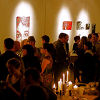




Aristocrat Swizzle
– Keith Waldbauer
1-3/4 oz gin
3/4 oz lime juice
10 mint leaves
dash simple syrup
1 barspoon green Chartreuse
Muddle mint and syrup in a mixing glass. Add gin and lime juice, and shake with ice. Strain into an empty Collins glass, fill with crushed ice, and top with a Chartreuse float. Garnish with a sprig of mint.
bar culture, Drink of the Week, drinks, Seattle
2 Comments »




Posted by Anita on 11.17.08 11:02 PM
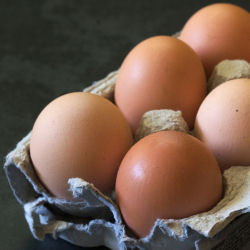 “I can’t wait to show you what I’m sneaking down in my bag,” wrote Laura. “Hopefully you’ll be as delighted as I am!”
“I can’t wait to show you what I’m sneaking down in my bag,” wrote Laura. “Hopefully you’ll be as delighted as I am!”
I knew we would be thrilled with whatever she brought us, and I suspected she’d be stocking our pantry with a fun assortment of jars — she’s an accomplished canner. But what actually landed on our kitchen counter was a jaw-dropping surprise.
Sure, there was a pint of (homegrown) dilly beans, and a pot of (homemade) strawberry jam. But there was also a shrink-wrapped frozen broiler chicken from the farm… and — wait for it — a dozen fresh eggs from the hennery itself … which Laura had brought down in her checked bags! (Eggs, says the TSA, contain more than 3oz of liquid in each “container”. And in any case, a dozen would definitely not fit in a quart-sized Ziploc bag.)
I wish I had thought to take a photo of Laura’s ingenious packaging: two half-dozen cardboard containers inside a perfectly sized plastic food-storage container, all wrapped in packing tape. And miraculously, every last egg made it here intact, with not a single crack.
This, my friends, is the way to get invited back for a return visit!
The three of us ate six of the eggs poached with a big batch of Cameron’s hash on Sunday morning. The yolks were almost fluorescent orange, and the whites held together like magic. (I forgot to take photos — d’oh!) There was Acme toast, too, with a generous slathering of Spring Hill butter and Laura’s no-pectin preserves — not too sweet, soft and fresh-tasting.
We toyed briefly with trying out a new recipe to share here on the blog, but decided that this bird needed little more than a good roasting and some simple accompaniments — we didn’t want to bury the flavor with complicated preparations. The chicken sat salted in the fridge all day, its skin drying out in preparation for a turn on the rotisserie tonight. After 90 minutes on the spit, it emerged golden and crispy-skinned, with juicy white meat and fabulous flavor: Truly the best bird we’ve eaten since the Hoffmans left the market.
SheHe’s a big bird, by farmers market standards — nearly 4 pounds — and we’re looking forward to making chicken pot-pie later in the week with the leftovers. And of course the bones and cartilage will be saved for our next batch of stock. Most guests leave little more than a pile of sheets in the laundry room; a fridge full of home-grown food is sure a welcome change!
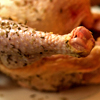
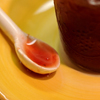

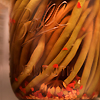
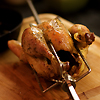
cooking, other blogs, travel
6 Comments »




Posted by Cameron on 10.13.08 10:46 PM
 If there is a drink out there with fewer redeeming qualities than the Jäger Bomb, I can’t imagine what it is. Seriously folks, this drink is a bad idea. It tastes like cough syrup, it’s loaded with sugar, it packs enough caffeine to instantly add fifty points to your heart rate, and one of the main ingredients is made entirely of industrial chemicals.
If there is a drink out there with fewer redeeming qualities than the Jäger Bomb, I can’t imagine what it is. Seriously folks, this drink is a bad idea. It tastes like cough syrup, it’s loaded with sugar, it packs enough caffeine to instantly add fifty points to your heart rate, and one of the main ingredients is made entirely of industrial chemicals.
And so, in honor of Stevi’s Mixology Monday topic, Guilty Pleasures, I’m horrified to share with you that I’m completely, utterly addicted to the Trailer Trash Speedball, the Turbojäger, the Flying Hirsch, La Perla Negra: The Jäger Bomb.
I picked up this dirty little habit during my tour of duty as a guitar player for Seattle-area cover band Bad Alibi. For the first three months, I was fastidious about not drinking during performances. To tell the truth, for the first month, I was too panicked to even think about trying to play with a buzz on, which amused my band mates tremendously. They rarely got out of control, but every set was accompanied by beer and, to tell the truth, if our drummer wasn’t stoned, he couldn’t keep time at all.
Before the third and final set of the evening, one of the Alibi Boys would usually buy a round of Jäger Bombs. At first I declined to take part in the toxic trainwreck, but eventually I thought, “Don’t knock it if you haven’t tried it.”
Like any destructive obsession, ritual is an important part of the Jäger Bomb. A shot of Jägermeister, an herbal liqueur, is served next to a pint glass containing half a can of Red Bull energy drink. You drop the shot glass into the pint glass and chug the mixture. Think of it as a millennial boilermaker.
As I climbed back on stage after my first ever Jäger Bomb, I immediately understood the appeal. Our third sets usually ran from midnight to 1:45am. Fridays weren’t too bad, but we always played two nights in a row and the third set on Saturday could be tough. No matter how big the crowd was, by 12:30, the entire room was completely blasted. By 1am, the energy would start to fall off, and by 1:30, the only people upright were usually us and the bar staff.
 This is all by way of saying that if you run around playing high voltage rock and roll late at night, the Jäger Bomb starts to make a lot of sense. One produces a high, fine, jittery feeling, and two will definitely get your motor running. Drink three in quick succession and you might as well hand the bartender your credit card and have them call the cops now, just to save time.
This is all by way of saying that if you run around playing high voltage rock and roll late at night, the Jäger Bomb starts to make a lot of sense. One produces a high, fine, jittery feeling, and two will definitely get your motor running. Drink three in quick succession and you might as well hand the bartender your credit card and have them call the cops now, just to save time.
After about a year and a half of playing 5 hours a night, 2 nights a week, 3 weekends a month in roadhouses anywhere from 45 minutes to 2 hours outside the city, all while holding down a full time corporate day job, my attitude towards rock godhead changed. The crowds were getting smaller, the drives were getting longer, and there is absolutely nothing fun about breaking down the stage at 2am. When I left the band, I mostly stopped drinking Jäger Bombs, as it’s not the sort of thing that you order in polite company.
But every now and then I let the inner Neanderthal come out to play. I drop the shot into the glass, and fire back the mixture. As the tight rush crawls up my spine, I close my eyes and remember when the lights flashed, the fog billowed, and—with one foot on the monitor and a snarl on my lips—I delivered the mighty rock thunder to a sea of dancing hooligans.





Jäger Bomb
4oz of energy drink (roughly 1/2 can of Red Bull)
1 shot Jägermeister
Pour the energy drink in a pint glass. Drop the shot in the pint glass and drink the whole mess down. Rock on.
bar culture, Drink of the Week, drinks, Mixology Monday, recipes, Seattle
13 Comments »




Posted by Anita on 08.04.08 8:39 PM
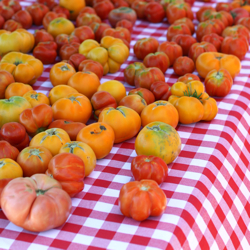 Once upon a time, Southern California was an agrarian epicenter where even small back yards usually boasted a mini-orchard, bursting with citrus or stone fruit.
Once upon a time, Southern California was an agrarian epicenter where even small back yards usually boasted a mini-orchard, bursting with citrus or stone fruit.
My father’s parents lived in semi-rural Monrovia, on a plot that included chickens, a kitchen garden, and a small avocado orchard that Dad tended to earn his allowance. Mom’s parents lived in suburban Glendale, but even their yard was full of edible options, including an enormous orange tree that we harvested for fresh-squeezed juice. As late as the 1980s, there were were actual citrus groves still supplying fruit for roadside stands near my childhood home in Orange.
But these days, urban blight and suburban sprawl have plowed under this once-fertile landscape; the names of streets and boulevards offer the last hint of the area’s pastoral past. Sadly, you’ll find no nuts on Nutwood, no oranges on Orangethorpe, no chiles in Anaheim. A few last pocket farms remain, but by and large they’re limited to mono-crops like strawberries or pumpkins… the kinds of u-pick items that scout troops and school groups will pay to see.
As you might imagine, an area this divorced from its farming heritage makes for a pretty tough locavore life. Despite a few large, well-regarded farmers markets, even the notion of a dedicated farm-to-table restaurant is pretty out on the fringe. LA Weekly–überfoodie Jonathan Gold laments that “the idea of locavore dining is more admired than actually practiced in Los Angeles, even at the restaurants where farmer-celebrities like Alex Weiser or the McGraths are treated with more awe than Matt Damon.”
For home cooks, local produce is widely available so long as your schedule and location make it easy for you to visit the bigger farmers markets in Irvine, Hollywood, or Santa Monica. But if you’re not able to shop on Saturday, you’re pretty much stuck with food of unknown origin. During our recent trip to the area, we rented a vacation house with my family for the week, and so we had access to a kitchen. But we got into town too late to hit the farmers markets… a mistake we will be sure not to repeat!
Much like the supermarkets back home in Northern California, none of those we visited in Los Angeles or Orange County offered any indication of where their food came from. Even Whole Foods was a joke: Items bottled in Napa Valley — at the other end of the state — were proudly labeled as “LOCAL!”. When we asked employees about this, they pointed out Whole Foods’ store policy: Anything raised within 7 hours of the market was considered local… perhaps the most liberal interpretation of locavorism that I can imagine. And although we’re used to having to pay close attention to sourcing even at our local Whole Foods, we were surprised that we didn’t see a single ‘local’ sign in the produce section.
But it was Henry’s Marketplace — part of the Wild Oats chain — that won the hypocrisy prize: A giant banner on the rear wall of the store read: “Choose LOCAL! Enjoy the freshest flavors from your community.” But in fact, the only local products we were able to find in the entire store were Broguiere’s milk (locally processed from semi-local, non-organic herds) and Henry’s own-brand eggs. Not a single fruit or vegetable bin was labeled with its point of origin, much less its farmer’s name.
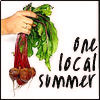 After much searching, we stumbled upon the website for South Coast Farms, one of Orange County’s last small-scale farm operations. We took a trek down Coast Highway to find that they do run a daily farm stand with a remarkably diverse set of offerings… our first clue that something wasn’t quite right. Turns out, only a handful of the items for sale are actually grown on site: Tomatoes, cucumbers, onions, and a few herbs. Others are ‘local’ — alas, no indication on signs of farms or even towns — and many are simply big-organic imports from South America. (Apparently, their CSA is a little more focused than the stand.)
After much searching, we stumbled upon the website for South Coast Farms, one of Orange County’s last small-scale farm operations. We took a trek down Coast Highway to find that they do run a daily farm stand with a remarkably diverse set of offerings… our first clue that something wasn’t quite right. Turns out, only a handful of the items for sale are actually grown on site: Tomatoes, cucumbers, onions, and a few herbs. Others are ‘local’ — alas, no indication on signs of farms or even towns — and many are simply big-organic imports from South America. (Apparently, their CSA is a little more focused than the stand.)
Working on a tip that Cal Poly Pomona offered local meat processed by their students, we took a trip out to the Farmstore at Kellogg Ranch. We did find local protein, but frozen chickens and a few sausages were all that the cases held. (Perhaps the stock is better during the school year?) Once again, it was anyone’s guess whether the fruits and veggies on offer were grown locally; there were a number of out-of-season crops for sale that made us suspect not. We got all excited over an entire wall of preserves, pickles, and sauces in quaint Mason jars, until we naively asked the store manager whether they were made by students, or just made from the farm’s own crops. “Oh, no…” she replied, with a tone that implied we’d just rolled off the turnip truck, “We just buy them from a company that puts our label on them.”
Defeated, we stopped into one of the smaller weekday farmers markets to see what we could cobble together. Although there couldn’t have been more than a dozen stalls, the mostly-Latino farmers offered a nice assortment of options: A basketful of tomatillos, a few heads of pungent celery, brown bags of fingerling potatoes, a huge pile of frying chiles, stacks of whiskery onions. Nobody seemed to be indulging in the luxury of specialization, which suited us just fine.
I won’t even go into the afternoon we spent trying to find local rolls for our sausages, but suffice to say we succeeded — even though we bought squishy commercial hoagie buns from the supermarket. A tiny corner store near our beach house supplied us with locally made tortilla chips, which we ate dipped in salsa verde made entirely from farmers market vegetables. For our entrees, we grilled up the German-style bratwurst we’d found at Cal Poly, topped them with a sauteed mix of peppers and onions, and served them on those supermarket buns. On the side, we had our favorite potato salad — everything locally sourced except the mayo and spices… and pickles from one of Kellogg Ranch’s faux-local canning jars.
Of course, it took us all week to get everything we needed, and our carbon footprint was enormous: We took the 100-Mile Diet to a literal extreme, racking up 90+ miles in the car on our search. I’m sure that with a little practice and a lot of hunting, we could find easier sources for much of what we drove around to find. But I’m thankful, more than ever, for the bounty that sits literally at my doorstep in San Francisco.
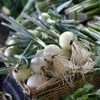

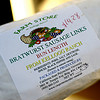
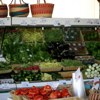
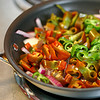
South Coast Farms
32701 Alipaz Street
San Juan Capistrano, CA 92675
(949) 661-9381
Monday through Saturday 9am to 5pm; Sundays 9am to 4pm
The Farmstore at Kellogg Ranch
4102 S. University Drive
Pomona, CA 91768
(909) 869-4906
Sunday through Friday 10am to 6pm; Saturday 8am to 6pm
Tustin Farmers Market
Corner of El Camino Real and 3rd Street
Tuesdays, 9am to 1pm
locavore, One Local Summer, SoCal
16 Comments »




Posted by Anita on 07.27.08 10:08 PM
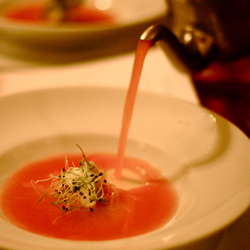 One of the hardest things about traveling is coming home to an empty fridge. Even back when we mostly shopped at the supermarket, this was one of the worst parts of any vacation. But now that we buy nearly all of our food at the farmers’ market, we’ve added a level of complexity to the mix.
One of the hardest things about traveling is coming home to an empty fridge. Even back when we mostly shopped at the supermarket, this was one of the worst parts of any vacation. But now that we buy nearly all of our food at the farmers’ market, we’ve added a level of complexity to the mix.
Luckily, we have a really nice Tuesday lunchtime farmers market at the Ferry Plaza; it’s much smaller than the Saturday showplace, but there’s just enough diversity to re-stock for a few midweek meals, especially if you hit up the indoor shops for meat and bread. So, our 100% local meal this week for One Local Summer included a Range Brothers pork chop dusted in Eatwell rosemary salt, Eduardo’s fusilli with Spring Hill butter, and some Iacopi Farms romano beans… a simple slice of summer.
But honestly, the foods we really wanted to be eating were back in New Orleans, where we spent the last week. Perhaps the feast of the week was our Spirited Dinner at Restaurant August, where chef John Besh created a mostly local, entirely seasonal menu with cocktail pairings by Charlotte Voisey, brand ambassador for Hendricks Gin.
Here’s the menu (and links to photos):
- Chilled melon “soup and salad” local charentais, watermelon, and Vietnamese herbs
- Belle River crawfish agnolotti with Allen Benton’s bacon, Honey Island chanterelles, and sweet fava beans
- Seafood-stuffed breast of local veal Silver Queen corn and crab risotto
- Heirloom tomato tarte tatin with creme fraiche ice cream
It was all quite lovely (well, perhaps excepting the dessert, which was much more interesting in concept than in execution) and it was fun to experience locavore life in another part of the country, where asparagus and favas are still in season, and crayfish — not crab — are fresh and plentiful. But honestly, as delicious as the high-falutin’ food was, it wasn’t very novel. Other than those crayfish, there wasn’t much that couldn’t have made an appearance at a Bay Area restaurant of August’s caliber. No, the true treasures of New Orleans’ local food scene were neither organic or sustainable.
 The Crescent City’s culinary delights are the stuff of legend. Even if you’ve never been to New Orleans, you’ve probably read of the glories of beignets and chicory coffee at Cafe du Monde. I’m sure you’ve heard of Central Grocery‘s legendary muffulettas, and the po-boys at places like Mother’s or Johnny’s. You might even have seen photos of Hansen’s Sno-Bliz, the world’s most perfect frozen delights, the kind of snow cones they might serve in heaven.
The Crescent City’s culinary delights are the stuff of legend. Even if you’ve never been to New Orleans, you’ve probably read of the glories of beignets and chicory coffee at Cafe du Monde. I’m sure you’ve heard of Central Grocery‘s legendary muffulettas, and the po-boys at places like Mother’s or Johnny’s. You might even have seen photos of Hansen’s Sno-Bliz, the world’s most perfect frozen delights, the kind of snow cones they might serve in heaven.
But as lovely as these made-to-order treats are, even the local stuff that comes in bottles and boxes tastes better in N’awlins than whatever it is you have at home. And nobody ever tells you about them! So let me be the first to suggest — nay, insist — that when you visit New Orleans, don’t miss out on some local treasures that can actually make the trip home with you.
Closest to my heart are Zapp’s — a brand of locally made potato chips that taste like a cross between Kettle Chips and manna from heaven. (And I bet you can’t find flavors like Spicy Cajun Craw-Tater, Dill Gator-Tater, or Spicy Creole Tomato back home.) Wash your chips down with a bottle of Abita amber beer, or a Barq’s root beer in the painted-label bottle… both of which taste much better in Louisiana than they do when you happen to run across them elsewhere.
Later, when your appetite comes back, make sure to find a Hubig’s pie or two. The closest analog is those Hostess ‘fruit pies’ you might have eaten as a kid, but they’re so much better that the comparison is entirely inadequate. No high-fructose corn syrup or hydrogenated soybean oil here, just beef fat and pure southern sugar. Their fruit fillings are made from actual fruit and sugar, not chemicals and essences. Tuck one in your carry-on bag for the flight home, and you’ll be the envy of your seat mates for sure.
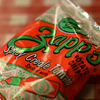
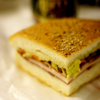
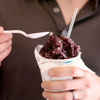
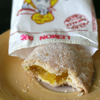
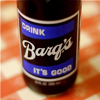
More New Orleans photos and notes on Flickr…
Spirited Dinner: At restaurant August, with cocktail pairings
Central Grocery: Muffulettas, Abita amber, and Zapp’s chps
Cafe du Monde: Beignets and chicory coffee
Mother’s: Ferdi po-boy (ham and ‘debris’)
Johnny’s Po-Boys: Crawfish po’boys, Cajun sausage po’boys, Barq’s root beer
Hansen’s Sno-Bliz: The best snow-cone treats in the cutest little shack
More New Orleans photos: Emeril’s, Tales sessions, Quarter scenery, and more
locavore, New Orleans, One Local Summer, restaurants
6 Comments »




Posted by Anita on 07.18.08 6:36 AM
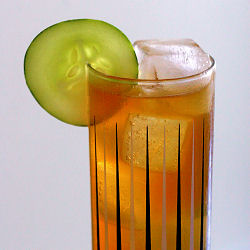 Few of our friends can believe that two people as obsessed with food and drink as we are have never been to New Orleans before. But it’s true: This week is our inaugural — although I think it’s safe to say definitely not our last — adventure in the City that Care Forgot.
Few of our friends can believe that two people as obsessed with food and drink as we are have never been to New Orleans before. But it’s true: This week is our inaugural — although I think it’s safe to say definitely not our last — adventure in the City that Care Forgot.
When Cameron mentioned at poker night last week that we were heading to New Orleans, our friend Dave’s eyes lit up. If there’s a San Franciscan who loves NOLA more than Dave, I sure don’t know him. He and his crew of roving debauchés have made their way to the Crescent City at least once a year for the past 11 years.
He sent us a 1,000-word-plus email, jammed with his favorite places and treats, devoting an entire paragraph (after 10 others on more-obscure offerings) just to the touristy French Quarter food & drink experiences that are actually worth the trouble:
“Get a cafe au lait and beignets at Cafe du Monde! Eat a muffaletta from Central Grocery on Decatur Street! Shoot oysters at Acme Oyster House! Get late-night eats and abuse from flaming waiters at Clover Grill! And drink a Pimm’s cup at Napoleon House bar!”
So, never one to pass up good advice, we hopped over to Napoleon House for lunch yesterday. We sat ourselves down amid glorious decrepitude and a century’s worth of graffiti, and ordered up a round of Pimm’s, a half a muffaletta, and a roast-beef po’boy. Ancient ceiling fans rotated overhead as bow-tied waiters shuttled between table, bar, and patio. Mid-meal, our Seattle cadre wandered in from the sidewalk swelter, followed closely by a friend from the other side of the continent. No fools, these drinkers: It was Pimm’s for everyone; tall, cool, and fast.
The Pimm’s Cup is our entry for this month’s Mixology Monday — aptly honoring the fine city of New Orleans, and even more aptly hosted by MxMo’s founder, Paul of Cocktail Chronicles. Now, frankly, I’m not sure how this quintessential English picnic drink became such a New Orleans standard. But if there were a Jeopardy! category called “Drinks of the Big Easy”, it’d be right there in the middle of the board, below the Hurricane, the Ramos Fizz, and the Sazerac, but above the Vieux Carre, the Obituary, and the La Louisiane. No matter the reason for its iconic status, it’s certainly a long, cool refresher that makes a potent antidote to the sticky New Orleans weather, and it’s known as a respectable option for daytime drinking… a pastime in which the Crescent City excels.


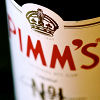

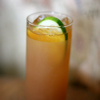
Pimm’s Cup
– Napoleon House, New Orleans
Food & Wine Cocktails 2008
1-1/2 oz Pimm’s No. 1
2-1/2 oz fresh lemon juice
1 oz simple syrup
1-1/2 oz chilled lemon soda (preferably French-style ‘lemonade’, but 7up will do)
cucumber wheel, for garnish
 Add the Pimm’s, lemon juice, and simple syrup to a cocktail shaker. Add ice and shake well, straining into an ice-filled colling glass. Stir in the soda, and garnish with the cucumber wheel.
Add the Pimm’s, lemon juice, and simple syrup to a cocktail shaker. Add ice and shake well, straining into an ice-filled colling glass. Stir in the soda, and garnish with the cucumber wheel.
bar culture, Drink of the Week, Mixology Monday, New Orleans, recipes, Tales of the Cocktail
19 Comments »




Posted by Cameron on 07.17.08 3:29 PM
Married…with dinner is in New Orleans this week for Tales of the Cocktail. This entry is crossposted from Blogging Tales of the Cocktail, where we’re honored to be among the contributors.
Coherent thought is simply too much to ask for after a night of boozing with trained professionals in one of the world’s finest party towns. Even a bag of Zapp’s Cajun Dill Gator-Tators doesn’t seem to be helping to organize my fractured, kaleidoscopic impressions of our first night in Crescent City. And so, expect none from this particular NOLA/Tales virgin.
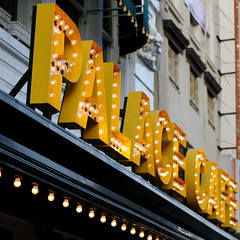 After we dropped our bags and grabbed our press credentials on Wednesday night, we headed off to the Palace Cafe. A pair of Beefeaters in full costume greeted us, followed by a bright-eyed nymphette wearing a Union Jack halter and not much else. We slipped into the main party area, and fought through teeming crowds to the bar to grab drinks. Properly fortified, we turned to survey the scene and realized that we had jumped a line 25 people long. Encouraged at getting the week started on the right foot, we pressed on.
After we dropped our bags and grabbed our press credentials on Wednesday night, we headed off to the Palace Cafe. A pair of Beefeaters in full costume greeted us, followed by a bright-eyed nymphette wearing a Union Jack halter and not much else. We slipped into the main party area, and fought through teeming crowds to the bar to grab drinks. Properly fortified, we turned to survey the scene and realized that we had jumped a line 25 people long. Encouraged at getting the week started on the right foot, we pressed on.
The next couple of hours flashed by in a whirl of gin and noise as we put faces to the names of electronic friends—many of them posting here.
 Eventually we were ready for new scenery so we set sail for Arnaud’s, the second destination of the evening. If the Palace was busy, Arnaud’s was packed. We squeezed in like toothpaste going back into the tube and finally found a slightly-less-insane corner toward the rear. Some friends were already here and as more arrived, I began to feel like I hadn’t really gone anywhere. I had joined a roving celebration that flowed from event to event, from place to place, as if the Quarter wasn’t made of separate buildings and bars, but rooms in a single grand mansion.
Eventually we were ready for new scenery so we set sail for Arnaud’s, the second destination of the evening. If the Palace was busy, Arnaud’s was packed. We squeezed in like toothpaste going back into the tube and finally found a slightly-less-insane corner toward the rear. Some friends were already here and as more arrived, I began to feel like I hadn’t really gone anywhere. I had joined a roving celebration that flowed from event to event, from place to place, as if the Quarter wasn’t made of separate buildings and bars, but rooms in a single grand mansion.
 Some started the evening at the Carousel Bar at the Hotel Monteleone. We ended there, twirling around the bartenders and mirrored center column as day one turned into day two.
Some started the evening at the Carousel Bar at the Hotel Monteleone. We ended there, twirling around the bartenders and mirrored center column as day one turned into day two.
bar culture, drinks, New Orleans, other blogs, Tales of the Cocktail, travel
Comments Off on First visit, first Tales




Posted by Anita on 05.04.08 11:30 PM
 Â A few years ago on May 5, I found myself in Puebla — the city where the historic Cinco de Mayo victory of Mexican forces over their French invaders took place. When I asked my taxi driver if there were any festivities planned to commemorate the anniversary, he looked at me like I was crazy: “It’s a military holiday, mija.”
 A few years ago on May 5, I found myself in Puebla — the city where the historic Cinco de Mayo victory of Mexican forces over their French invaders took place. When I asked my taxi driver if there were any festivities planned to commemorate the anniversary, he looked at me like I was crazy: “It’s a military holiday, mija.”
Even in Puebla, the idea of Cinco de Mayo as an event worthy of feasting and celebration seemed utterly unknown. Every Poblano who I told of the norteamericano version of the holiday — at best a celebration of Mexican-American pride, at worst an excuse to drink excessive quantities of nasty sour-mix Margaritas — expressed complete astonishment, shaking their heads as though they’d just discovered yet another reason to pity our confused country.
But no matter: I hadn’t gone to Puebla in search of patriotic parades or folklorico dancing in the city squares. I’d gone there to spend a few days relaxing before meeting friends in the bustle of Mexico City, to explore the city’s beautiful colonial architecture, and to eat Puebla’s famously delicious food.
Strolling the streets the morning of my arrival, I found a peasant woman standing in a tiny off-the-path plaza, selling tamales out of a steaming metal can. There were three choices, but I barely registered the first two: The last, the one I chose, was mole. There are many moles in Mexico of course, but the best-known — the chocolate-tinged, brick-red one most Americans think of when they think of mole — hails from Puebla. Reputedly invented by an order of nuns in honor of their bishop’s visit, mole poblano is sinfully delicious and worth every bit of the hassle it takes to make it. It also makes an excellent tamale filling, a perfect breakfast after 12 hours of travel by plane and bus and taxi.
Thus fortified, I wandered Puebla’s tidy grid of streets without much of a plan. I explored the cathedral of the angels, considered one of the country’s most stunning churches, followed by a plate of tacos árabes at a tile-bright shop called Tacos Tony. I watched the propane vendors ply their wares: Pulling their truck up to the middle of a residential block, they blared their promotional jingle — a festive snippet of dance music, punctuated by a deep bass voice crying “EL GAZ!!” — and the ladies of the house would come to the street bearing tanks to be filled. On my way to the Mercado Carranza, I stumbled across a Victorian-era shopping arcade featuring an enormous stained-glass gazebo and cobblestone footpaths. And once I reached the mercado, I discovered my favorite Puebla snack: Cemitas, at a stand called El As de Oros.
Some folks will tell you that a cemita is little more than a torta served on a Puebla-style roll rather than a more typical bolillo, but the differences run a little deeper. Like tortas, cemitas are available with the diner’s choice of meat fillings — stew-like tinga, crispy carnitas, chewy cueritos, or golden-brown milanesa. And like tortas, cemitas are essentially a taco on a bun.
Unlike a torta, though, you rarely see mayonnaise on a cemita, nor frijoles; lettuce is a definite no-no. Aside from the meat, toppings nearly always include a generous amount of avocado, a bouncy cheese like panela or queso de Oaxaca, a slather of salsa roja, and a pungent herb called papalo. Like tacos árabes, cemitas have their roots in the cuisine of Puebla’s Lebanese immigrants. The word itself means “semite”, a nod to the soft, eggy, sesame-seeded rolls borrowed from the Arabic kitchen.
Alas, unlike in Los Angeles — where a gaggle of cemita trucks are giving their taco-vending cousins a serious run for the money — you’d be hard pressed to find a cemita for sale in San Francisco. But of all the comidas tÃpicas poblanas, cemitas are the easiest to make. Even if you quake at the thought of a day-long adventure required to make authentic mole poblano, or the near-impossible task of replicating spit-grilled tacos árabes at home, cemitas are a cinch.
The ones we’re enjoying as our Cinco de Mayo treat are filled with the homemade chicken-fried-steak called milanesa, arguably the most-popular cemita filling. But if you’ve got some carnitas or tinga left over from your own festivities, I guarantee they’ll find a happy home between two halves of a sesame-seed bun.

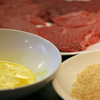
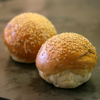

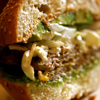
Cemitas Poblanas de Milanesa
1 pound beef sirloin tips, pounded thin
1/2 cup flour, seasoned with 2tsp salt and 1tsp pepper
1 egg, well scrambled with 1T water
1/2 cup fine breadcrumbs
oil for frying
—–
4 challah rolls, preferrably sesame seeded
1 mild white or red onion, sliced thickly
8 oz panela or queso de Oaxaca, or other fresh and creamy Mexican cheese
your favorite mexican salsa roja (the cooked smooth sort, not like pico de gallo)
– or substitute a few pureed chiles chipotles en adobo thinned with water or vinegar
2 large avocados, peeled and sliced
16 sprigs of papalo (or substitute cilantro)
Pound the meat flat with a meat tenderizer, 1/4-inch or thinner, and pat dry with a paper towel. If the pieces are larger than sandwich size, you may want to cut them apart. Dredge the meat in the seasoned flour, brushing off any excess until just the thinnest layer remains. Dip quickly in the egg, again taking care to leave as little as possible on the meat, and then a light layer of breadcrumbs.
In a deep skillet, add sufficient oil to shallow-fry at a depth of 1/4 inch. (In my 10-inch skillet, I used about 3/4 cup.) Heat the pan over medium heat until oil is shimmering but not smoking. Place the breaded meat in the pan and fry until golden brown on both sides, just a few minutes total. Remove from the pan and keep warm on a cooling rack in a warm oven.
Cut the buns in half, and lightly toast under a broiler or on a griddle. While buns are toasting, coarsely smash 1/3 of the avocado in a bowl with the back of a fork. Spread the mashed avocado on the bottom of each bun, and season with salt. Pour the salsa onto a small saucer, and dip the top half of each bun into the salsa to coat; set aside. Top the bottom half of the bun with a piece of the milanesa, followed by cheese, onions, papalo or cilantro, and the remaining sliced avocados, and the salsa-smeared top.
Something to drink?
– Margaritas: Drink of the Week 9/15/06
– Michelada: Drink of the Week 11/24/06
– Sangrita: Drink of the Week 6/1/07
holidays & occasions, meat, Mexican, travel
3 Comments »




Posted by Anita on 03.27.08 7:57 PM
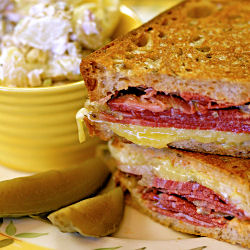 There’s a strange thing that happens in Seattle. (OK, there are many strange things that happen there, but this one is food related.) Some restaurant — usually a reasonably popular one — puts a relatively obscure but approachable item on the menu, and before you can say “hamburger with a fried egg on top”, said item pops up on menus everywhere, from divey diners to haute-cuisine haunts.
There’s a strange thing that happens in Seattle. (OK, there are many strange things that happen there, but this one is food related.) Some restaurant — usually a reasonably popular one — puts a relatively obscure but approachable item on the menu, and before you can say “hamburger with a fried egg on top”, said item pops up on menus everywhere, from divey diners to haute-cuisine haunts.
Thus it is with the Reuben, the sandwich some might call Seattle’s signature. And it’s no great mystery why: There’s something irresistibly naughty — not to mention entirely un-Kosher — about a deli sandwich that combines salty corned beef, gooey cheese, zippy Russian dressing, and crunchy sauerkraut between two slices of butter-grilled rye bread. A Reuben is the perfect antidote for drizzly, chilly Northwest weather, an overstuffed slice of golden sunshine on a plate. Served with a garlicky dill pickle and a ramekin of good potato salad, there’s hardly any better cure for grey-day blues.
Child of the sunny Southland that I am, it’s entirely possible that I had never eaten a Reuben before we moved to Jet City. I quickly made up for lost time: Fremont’s Red Door tavern used to make a pretty good example, as did our old ‘local’ pub, the 74th Street Ale House on Phinney Ridge. Once we moved across town to Madison Valley, it was only a matter of days before I discovered the heavenly Reuben — and his turkey-licious sibling, Rachel — served on just-baked sour rye at the Essential Bakery Cafe. I could probably fill an entire post with Seattle Reubens I Have Known and Loved. (Thankfully, I managed to avoid the vegan one!)
Once we moved back home to San Francisco, I don’t think I ever encountered a Reuben on a restaurant menu. I’m sure Reubens exist somewhere within our seven-by-seven grid, but so far we have yet to cross one another’s paths. It’s a sad truth that moving from city to city often means leaving behind foods (and friends) you’ve grown to love.
Luckily, once you have the right ingredients, it’s easy to make your own fabulous Reuben. Sure, you can pick up pretty good deli meats around town, but one of the the best reasons to make your own corned beef is that you’ll have plenty of leftovers. Leave the little trimmings and end bits for tomorrow morning’s hash; the best and highest use of that glistening chunk of pink, lipid-laced meat lies between two slices of good bread. Shave it thin with your sharpest blade, and don’t stop until you’ve got a goodly pile.
—-
Knowing there were Reubens in our future, we picked up a loaf New York Rye from Acme and a hunk of Spring Hill’s Portuguese cheese, which makes a better-than-decent stand-in for Swiss. We thought we would be out of luck finding local sauerkraut, until fate intervened. The good news: Not one but two of our favorite local purveyors has just recently started brining their own ‘kraut. Fatted Calf sells a chunky, tangy variety, and Alexander Valley Gourmet sells a crisper, finer-gauge flavor. Happily, both are excellent, and equally well suited to Reuben-making.
The bad news: Neither brand is (yet) available in San Francisco. Fatted Calf sells theirs over the counter at their Oxbow shop but, alas, not at their market stands. Alexander Valley is wrestling with the classic shelf-space squeeze: So far, no San Francisco shop has made room for their newest product. (There’s hope, though: Alexander Valley’s fresh pickles are already available at Whole Foods, Rainbow Grocery, and Andronico’s; if you want the ‘kraut, too, leave a note for the manager asking that they stock it. So far, the new Napa branch of Whole Foods is as close as we’ve been able to locate it.)
With two containers of locally made sauerkraut in the fridge, all that remained was the Russian dressing. We stirred together some homemade mayo, a bit of last summer’s tomato jam, a blob of local horseradish, a few chopped pickles… and got ready to griddle. Sure, Thousand Island dressing would have done in a pinch, but we decided that making a 100%-local sandwich was worth a few minutes of extra prep.
And let me tell you: It was a Reuben to make you forget all the others.
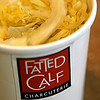
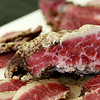
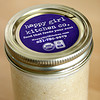

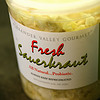
The Perfect Reuben Sandwich
Here’s the part where I would normally explain exactly how to craft the platonic ideal of a Reuben sandwich. But frankly, there’s no way I could possibly improve on the recipe we found on Epicurious, as transcribed from Arthur Schwartz’s New York City Food.
If you think the Zuni Cafe mock porchetta recipe is detailed, let me assure you: It ain’t got nothin’ on Schwartz’s step-by-step tutorial on building the proper Reuben sandwich. The devil may be in the details, but the details are in Schwartz’s Reuben.
Dark Days challenge, locavore, lunch, Seattle
14 Comments »




 Here’s a recipe for a magical midwinter’s afternoon: Take the Tube to Richmond, a village on the fringes of London, then hop a red double-decker bus for a ride along the Thames. Alight in front of the cheery half-timbered pub, walk down the church lane past the Celtic stone crosses, left at the split-rail fence, and bob’s your uncle: You’ve arrived at Petersham Nurseries.
Here’s a recipe for a magical midwinter’s afternoon: Take the Tube to Richmond, a village on the fringes of London, then hop a red double-decker bus for a ride along the Thames. Alight in front of the cheery half-timbered pub, walk down the church lane past the Celtic stone crosses, left at the split-rail fence, and bob’s your uncle: You’ve arrived at Petersham Nurseries.




























































